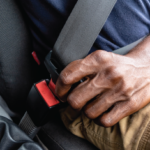
No matter how far you get in karate or in life, you are always a student.
BRG.photography/shutterstock.com
Robert Thoburn, MD, finds discipline and the opportunity for continual learning in both rheumatology and karate, an activity he has pursued for decades.
Karate Lessons
“I was fortunate to have had the opportunity to learn karate and achieve a black belt,” Dr. Thoburn says. “I used my training journal and [did] extensive research to write a book, Karate: Olympic Style Kumite (Infinity Publishing, June 24, 2002). This was largely to explore my own thinking on the topic, to consolidate the information and perhaps add something to the body of literature.
“Some of what I learned were the Bushido code, or way, chunking and self-defense. An important lesson for children taking up karate is the concept of chunking. The belt system breaks karate down to chunks of information. After each chunk is mastered, a belt is awarded. The lesson children learn is that anything can be learned or achieved by practicing small segments of information and layering on that.”
Introduction to Rheumatology
Dr. Thoburn, who was exposed to the debilitating effects of rheumatoid arthritis early in life, says, “Perhaps one reason I went into rheumatology was because my mother had RA in later life. A turning point for her as an artist was when she could no longer handle the framed canvasses in the trunk of her car to set up for shows,” he recalls.
He says rheumatology allows him to use critical-thinking skills at a higher level than many other areas he might have pursued. “I love the immunology—the interlinking of the innate and adaptive immune system, inflammation and the coagulation system that lead to autoimmune and auto-inflammatory diseases,” he says. “The movement is toward personalized medicine, [in which] an environmental trigger interacts with a single gene mutation or a set of gene variations that cause disease and may allow specific therapeutic pathway modification and better disease control.”
Dr. Thoburn teaches at the University of Florida. He is an associate professor of medicine in the Division of Rheumatology and Clinical Immunology. “As an adjunct professor I have the privilege to attend rheumatology clinics as an observer, learner and teacher,” he says. “Interacting with very bright students, residents and fellows is a delight. Learning while teaching is a pleasure. Having nephrologists and pulmonologists interacting with rheumatologists in the same clinic has improved patient care and reduced patient clinic visits.”
‘Anything can be learned or achieved by practicing small segments of information & layering on that.’ —Dr. Thoburn
He also works at the Acorn Medical Clinic in Brooker, Fla., and still enjoys putting in a half-day every two weeks. “I have had the privilege of seeing patients with rheumatic diseases in a volunteer rural clinic for many years,” he says. “Many of these patients have little or no health insurance. Getting needed services can be a challenge for them and the physician. In a way, it is a return to the black bag of tools to diagnose and treat patients.”
Time is a challenge to the practice of rheumatology, he says. Although technology has saved time in some respects, in others, he says, the introduction of technology has actually resulted in a longer journey to the proper result. “There is a push in medicine to see more patients, which results in less detailed history taking and physical examination; less time for critical thinking,” he says. “This sometimes leads to a greater need for expensive testing and technology to get answers. In this environment, achieving empathy and patient satisfaction can be a struggle.”
Although many of his contemporaries have since retired, Dr. Thoburn doesn’t see his career coming to an end anytime soon and, in fact, was recently asked by the medical school to expand his role in the clinic.
Always Learning
He says the students he comes across during his workweek teach him as much as he teaches them. After all, he says, no matter how far you get in karate or in life, you are always a student.
Eric Butterman is a Texas-based freelance writer.


